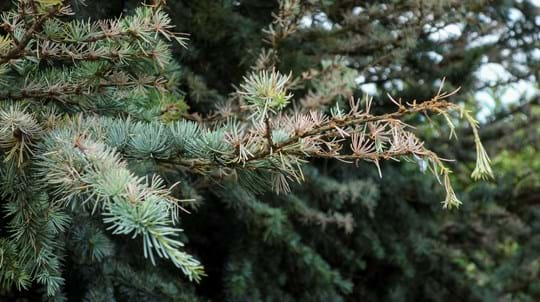
Pests and diseases
Sirococcus tsugae
A fungal disease that attacks cedars and hemlock.

Forest Research
Cedars are non-native evergreen conifers that historically have been used as ornamentals in gardens and estates in Britain. More recently, cedars have been considered as an alternative forestry species particularly on drier sites in southern and eastern Britain.
The main three species grown in Britain are:
Lebanon cedar (from the mountains of Lebanon, south central Turkey and western Syria)
Deodar cedar (from the Himalayas)
Atlas cedar (from the Atlas Mountains of North Africa, in northern Morocco and northern Algeria)
Cedars are generally pest and disease-free. However in the last two years Atlas cedars have been affected by severe shoot blight and defoliation.
At the Tree Health Diagnostic & Advisory Service (THDAS) we identified the causal agent as the fungus Sirococcus tsugae. This was the first record of the fungus in Britain as it was previously only recorded in North America on hemlocks and Atlas and Deodar cedars. Almost at the same time of the discovery of Sirococcus tsugae in Britain, it was also detected in Germany on Atlas cedar. At THDAS we have been studying the distribution of the disease in the UK, trying to find out if other cedar species can also be affected. We also want to learn more about the life cycle of the fungus.
So how do you recognise the disease on Atlas cedar? In the spring, affected trees develop dead needles on the shoots, dead shoots, cankers and gum exudation. Dead needles are very distinctive as they turn ‘pink’ in colour. Later they become brown as the season progresses. This pink colour of the needles is very characteristic on affected Atlas cedars.
In North America the fungus affects two cedar species – Deodar and Atlas cedar. In Britain we have only found this fungus on Atlas cedar. For this reason, we would like you to report any sightings of Deodar or Lebanon cedars showing shoot blight. We are not sure if they will show pink needles though!
Sirococcus tsugae has not yet been found on cedar of Lebanon anywhere in the world. Interestingly, Observatree volunteers have detected shoot dieback on cedar of Lebanon and we have been able to identify another Sirococcus species – S. conigenus. This species is a common species in the northern hemisphere and causes a shoot dieback which is not of major concern. We have not detected S. conigenus either on Atlas cedar or on Deodar cedar in Britain. In fact, we have not detected any Sirococcus species on Deodar cedar.
These facts show just how complex a disease can be – we have the same fungus affecting Atlas cedar on two continents but causing different symptoms. In North America it causes shoot blight whilst here the same fungus can cause shoot blight, branch/stem cankers and even be responsible for the death of young trees. We have cedar species that are affected on one continent and not on the other even though the fungus is present. We are still not sure if this fungus will manage to jump to the other cedar species over time.
So…pink needles or not, please keep looking out to help us build up the real picture of the situation in Britain.